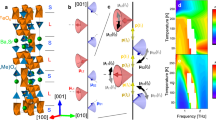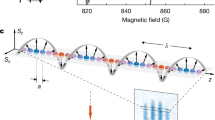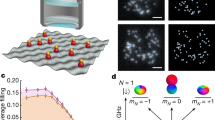Abstract
The existence of bound states of elementary spin waves (magnons) in one-dimensional quantum magnets was predicted almost 80 years ago1. Identifying signatures of magnon bound states has so far remained the subject of intense theoretical research2,3,4,5, and their detection has proved challenging for experiments. Ultracold atoms offer an ideal setting in which to find such bound states by tracking the spin dynamics with single-spin and single-site resolution6,7 following a local excitation8. Here we use in situ correlation measurements to observe two-magnon bound states directly in a one-dimensional Heisenberg spin chain comprising ultracold bosonic atoms in an optical lattice. We observe the quantum dynamics of free and bound magnon states through time-resolved measurements of two spin impurities. The increased effective mass of the compound magnon state results in slower spin dynamics as compared to single-magnon excitations. We also determine the decay time of bound magnons, which is probably limited by scattering on thermal fluctuations in the system. Our results provide a new way of studying fundamental properties of quantum magnets and, more generally, properties of interacting impurities in quantum many-body systems.
This is a preview of subscription content, access via your institution
Access options
Subscribe to this journal
Receive 51 print issues and online access
$199.00 per year
only $3.90 per issue
Buy this article
- Purchase on Springer Link
- Instant access to full article PDF
Prices may be subject to local taxes which are calculated during checkout




Similar content being viewed by others
References
Bethe, H. A. Zur Theorie der Metalle. Z. Phys. 71, 205–226 (1931)
Caux, J.-S. & Maillet, J. M. Computation of dynamical correlation functions of Heisenberg chains in a magnetic field. Phys. Rev. Lett. 95, 077201 (2005)
Pereira, R. G., White, S. R. & Affleck, I. Exact edge singularities and dynamical correlations in spin-1/2 chains. Phys. Rev. Lett. 100, 027206 (2008)
Kohno, M. Dynamically dominant excitations of string solutions in the spin-1/2 antiferromagnetic Heisenberg chain in a magnetic field. Phys. Rev. Lett. 102, 037203 (2009)
Imambekov, A., Schmidt, T. L. & Glazman, L. I. One-dimensional quantum liquids: beyond the Luttinger liquid paradigm. Rev. Mod. Phys. 84, 1253–1306 (2012)
Bakr, W. S. et al. Probing the superfluid-to-Mott insulator transition at the single-atom level. Science 329, 547–550 (2010)
Sherson, J. F. et al. Single-atom resolved fluorescence imaging of an atomic Mott insulator. Nature 467, 68–72 (2010)
Ganahl, M., Rabel, E., Essler, F. & Evertz, H. Observation of complex bound states in the spin-1/2 Heisenberg XXZ chain using local quantum quenches. Phys. Rev. Lett. 108, 077206 (2012)
Wortis, M. Bound states of two spin waves in the Heisenberg ferromagnet. Phys. Rev. 132, 85–97 (1963)
Takahashi, M. One-dimensional Heisenberg model at finite temperature. Prog. Theor. Phys. 46, 401–415 (1971)
Hanus, J. Bound states in the Heisenberg ferromagnet. Phys. Rev. Lett. 11, 336–338 (1963)
Fogedby, H. C. The spectrum of the continuous isotropic quantum Heisenberg chain: quantum solitons as magnon bound states. J. Phys. C 13, L195–L200 (1980)
Schneider, T. Solitons and magnon bound states in ferromagnetic Heisenberg chains. Phys. Rev. B 24, 5327–5339 (1981)
Schreiber, A. et al. A 2D quantum walk simulation of two-particle dynamics. Science 336, 55–58 (2012)
Lahini, Y. et al. Quantum walk of two interacting bosons. Phys. Rev. A 86, 011603(R) (2012)
Venegas-Andraca, S. E. Quantum walks: a comprehensive review. Quant. Inf. Proc. 11, 1015–1106 (2012)
Bose, S. Quantum communication through spin chain dynamics: an introductory overview. Contemp. Phys. 48, 13–30 (2007)
Subrahmanyam, V. Entanglement dynamics and quantum-state transport in spin chains. Phys. Rev. A 69, 034304 (2004)
Batchelor, T. The Bethe ansatz after 75 years. Phys. Today 60, 36–40 (2007)
Date, M. & Motokawa, M. Spin-cluster resonance in CoCl2·2H2O. Phys. Rev. Lett. 16, 1111–1114 (1966)
Torrance, J. B. & Tinkham, M. Excitation of multiple-magnon bound states in CoCl2·2H2O. Phys. Rev. 187, 595–606 (1969)
Hoogerbeets, R., van Duyneveldt, A. J., Phaff, A. C., Swüste, C. H. W. & de Jonge, W. J. M. Evidence for magnon bound-state excitations in the quantum chain system (C6H11NH3)CuCl3 . J. Phys. C 17, 2595–2608 (1984)
Winkler, K. et al. Repulsively bound atom pairs in an optical lattice. Nature 441, 853–856 (2006)
Fölling, S. et al. Direct observation of second-order atom tunnelling. Nature 448, 1029–1032 (2007)
Kuklov, A. & Svistunov, B. Counterflow superfluidity of two-species ultracold atoms in a commensurate optical lattice. Phys. Rev. Lett. 90, 100401 (2003)
Duan, L.-M., Demler, E. & Lukin, M. Controlling spin exchange interactions of ultracold atoms in optical lattices. Phys. Rev. Lett. 91, 090402 (2003)
Weitenberg, C. et al. Single-spin addressing in an atomic Mott insulator. Nature 471, 319–324 (2011)
Fukuhara, T. et al. Quantum dynamics of a mobile spin impurity. Nature Phys. 9, 235–241 (2013)
Trotzky, S. et al. Time-resolved observation and control of superexchange interactions with ultracold atoms in optical lattices. Science 319, 295–299 (2008)
Nishida, Y., Kato, Y. & Batista, C. D. Efimov effect in quantum magnets. Nature Phys. 9, 93–97 (2013)
García-Ripoll, J. J. & Cirac, J. I. Spin dynamics for bosons in an optical lattice. New J. Phys. 5, 76 (2003)
Altman, E., Hofstetter, W., Demler, E. & Lukin, M. D. Phase diagram of two-component bosons on an optical lattice. New J. Phys. 5, 113 (2003)
Pertot, D., Gadway, B. & Schneble, D. Collinear four-wave mixing of two-component matter waves. Phys. Rev. Lett. 104, 200402 (2010)
Hoefer, M. A., Chang, J. J., Hamner, C. & Engels, P. Dark-dark solitons and modulational instability in miscible two-component Bose-Einstein condensates. Phys. Rev. A 84, 041605 (2011)
Karbach, M. & Müller, G. Introduction to the Bethe ansatz I. Comput. Phys. 11, 36–43 (1997)
Acknowledgements
We thank H. G. Evertz, M. Haque, J.-S. Caux and W. Zwerger for discussions. We thank J. Zeiher for proofreading the manuscript. This work was supported by MPG, DFG, EU (NAMEQUAM, AQUTE, Marie Curie Fellowship to M.C.) and JSPS (Postdoctoral Fellowship for Research Abroad to T.F.).
Author information
Authors and Affiliations
Contributions
All authors contributed extensively to the work presented in this paper.
Corresponding author
Ethics declarations
Competing interests
The authors declare no competing financial interests.
Extended data figures and tables
Extended Data Figure 1 Quantum state analysis through the Bethe Ansatz.
a, Overlap of the initial state with the bound (red circles) and free (black dots) magnon states calculated for N = 16 lattice sites35. For illustration, we show only the states with wavevectors within the interval k ∈ [0,π/alat]. The inset b shows the corresponding energy spectrum. c, Spin–spin correlation of the magnon bound states as a function of the spin separation d = |j − i| for different wavevectors k. For k = π/alat the wavefunction of the bound magnon state corresponds to tightly bound spins on neighbouring sites, giving the largest overlap with our initial state.
Extended Data Figure 2 Propagation of bound magnons.
a, Calculated probability distribution  (black lines) together with the Bessel function fit (green lines) for different evolution times (40, 80 and 120 ms). The red vertical lines show the width extracted from the fit. b, Determination of the velocity. The red line is the extracted width from the Bessel function fits for different evolution times. The black line corresponds to the expected maximum velocity (Jexalat/2
(black lines) together with the Bessel function fit (green lines) for different evolution times (40, 80 and 120 ms). The red vertical lines show the width extracted from the fit. b, Determination of the velocity. The red line is the extracted width from the Bessel function fits for different evolution times. The black line corresponds to the expected maximum velocity (Jexalat/2 ).
).
Extended Data Figure 3 Propagation of free magnons.
Main figure, the blue and red lines show the Gaussian centre c and the centre plus the width, c + s. Note that the centre moves more slowly than the maximum wavefront velocity. The black line, almost overlapping with the red line, corresponds to twice the expected single magnon maximum velocity (2Jexalat/ ). Inset, an example of the Gaussian fit (green line). The grey circles represent the calculated correlation function
). Inset, an example of the Gaussian fit (green line). The grey circles represent the calculated correlation function  for the evolution time of 80 ms. The blue shading highlights the region used for the fit.
for the evolution time of 80 ms. The blue shading highlights the region used for the fit.
Source data
Rights and permissions
About this article
Cite this article
Fukuhara, T., Schauß, P., Endres, M. et al. Microscopic observation of magnon bound states and their dynamics. Nature 502, 76–79 (2013). https://doi.org/10.1038/nature12541
Received:
Accepted:
Published:
Issue Date:
DOI: https://doi.org/10.1038/nature12541
This article is cited by
-
Quantum simulations with ultracold atoms in optical lattices: past, present and future
Journal of the Korean Physical Society (2023)
-
Long-lived phantom helix states in Heisenberg quantum magnets
Nature Physics (2022)
-
How to build Hamiltonians that transport noncommuting charges in quantum thermodynamics
npj Quantum Information (2022)
-
Information scrambling and redistribution of quantum correlations through dynamical evolution in spin chains
Quantum Information Processing (2022)
-
Formation of robust bound states of interacting microwave photons
Nature (2022)
Comments
By submitting a comment you agree to abide by our Terms and Community Guidelines. If you find something abusive or that does not comply with our terms or guidelines please flag it as inappropriate.



